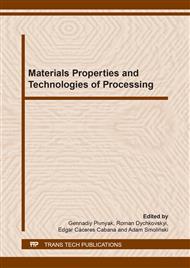[1]
Arzamasceva, B.N., & Muhina, G.G. (2002). Materialovedenie. M.: Izd-vo MGU im. N.E. Bau-mana.
Google Scholar
[2]
Solomaho, V.L., Tomilin, R.I., Citovich, B.V., Yudovin, L.G. (1990). Spravochnik konstruktora-priborostroitelya. Detali i mehanizmy priborov. Minsk.: Vysheysh. shk.
Google Scholar
[3]
Murray, J.L. (1985). The aluminium-copper system. Meta. International ls Reviews, (30), 211-235.
Google Scholar
[4]
Wolverton, C. (2001). Entropically Favored Ordering: The Metallurgy of Al2Cu Revisited, Physical review letters, 86(11), 5518-5521.
Google Scholar
[5]
Aaronson, H.I., & Laird, C. (1968). Structure and Migration Kinetics of Alpha: Theta Prime Boundaries in Al-4 Pct Cu: Part II-Kinetics of Growth. Trans. Metall. Soc. AIME, (242), 1437-1448.
Google Scholar
[6]
Plevachuk, Y., Sklyarchuk, V., Yakymovych, A, Eckert, S., Willers, B., Eigenfeld Density, Viscosity (2008). Electrical Conductivity of Hypoeutectic Al-Cu Liquid Alloys. Metallurgical and Material stransactions, (39), 3040-3045.
DOI: 10.1007/s11661-008-9659-2
Google Scholar
[7]
Konstantinova, N.Yu., Popel, P.S., & Yagodin, D.A. (2009). Kinematicheskaya vyazkost zhyidkih splavov med-alyuminiy. ТВТ, 47(3), 354- 359.
Google Scholar
[8]
Friedrichs, H.A., Ronkow, L.W., & Zhou, Y. (1977). Measurement of viscosity, density and surface tension of metal melts. Process metallurgy steel research, 68(5), 209-214.
DOI: 10.1002/srin.199701780
Google Scholar
[9]
Konstantinova, N.Y., & Popel, P.S. (2008). Kinematic viscosity of liquid Al-Cu alloys. 13th International Conference on Liquidand Amorphous Metals, Journal of Physics: Conference Series, 4.
DOI: 10.1088/1742-6596/98/6/062022
Google Scholar
[10]
Brillo, J., Bytchkov, A., & Egry, I., Hennet, L., Mathiak, I., Pozdnyakova, G., Pricec, D. L., Thiaudiered, D., & Zanghi, D. (2006). Local structure in liquid binary Al–Cu and Al–Ni alloys. Journalof Non-Crystalline Solids, (352), 4008-4012.
DOI: 10.1016/j.jnoncrysol.2006.08.011
Google Scholar
[11]
Mudrya, S., Shtablavyi, I., Shcherba, I. (2008). Liquid eutectic alloys as a cluster solutions. Archives of Materials Science and Engineering, 34(1), 14-18.
Google Scholar
[12]
Zamyatin, V.M., Nasyirov, Ya.A., Klassen, N.I. (1986). Anomalii na politermakh vyazkosti zhidkikh splavov sistemy alyuminii-med. Zhurnal fizicheskoi khimii, 60(1), 243-248.
Google Scholar
[13]
Bazin, Yu.A., Zamyatin, V.M., Nasyirov, Ya.A., & Emel'yanov, A.V. (1985). O strukturnykh prevrascheniyakh v zhidkom alyuminii Izv. Vyssh. Uchebn. Zaved., Chern. Met., (5), 28-32.
Google Scholar
[14]
Oliver, W.C., & Prahn, G.M. (2008). Animproved technique for determin in gelasticmodulus and conten timpurity in the metals. J. Materials. Res., 12(6), 564-583.
Google Scholar
[15]
Azhazha, V.M., Azarenkov, N.A., Semenenko, V.E., & Kuz'min, A.V. (2008). Osobennosti polucheniya i svoystva estestvennykh kompozitsionnykh materialov na osnove tugoplavkikh metallov. MFNT, 30(12), 277-288.
Google Scholar
[16]
Kalashnikov, E.V. (1977). Termodinamicheski neustoychivyie sostoyaniya v evtekticheskih sistemah. Journal of Technical Physics, 67(4), 7-12.
Google Scholar
[17]
Tverdokhlebova, S.V. (2007). Spectrometry of the boron-containing alloys, Vіsnik Dnіpropetrovskogo nacіonalnogo unіversitetu Serіja. fіzika. Radіoelektronіka, 14(12/1), 100-104.
Google Scholar
[18]
Liyakishev, N.P. (1966). Diagrammy sostoyaniya dvoynyh metallicheskih sistem. M.: Mashinostroenie, (1).
Google Scholar
[19]
Juk, N.P. (1991). Kurs teoriyi korroziyi i zaschiti metallov. М.: Metallurgiya, (1, 2).
Google Scholar
[20]
Klinov, I.Ya. (1967). Korroziya chimicheskoy apparaturi i korrozionnostoykiye materiali. М.: Mashinostroenie.
Google Scholar
[21]
Rozenfeld, I.L. (1970). Korroziya i zachita metallov. М.: Metallurgiya.
Google Scholar
[22]
Semenova, I.V., Florianovich, G.M., Horoshilov, А.V. (2006). Korroziya i zachita ot korrozii. М.: Fizmatlit.
Google Scholar
[23]
Todt, F. (1966). Korroziya i zachita ot korrozii. Korroziya metallov i splavov. Per. s nem., Chimiya.
Google Scholar


